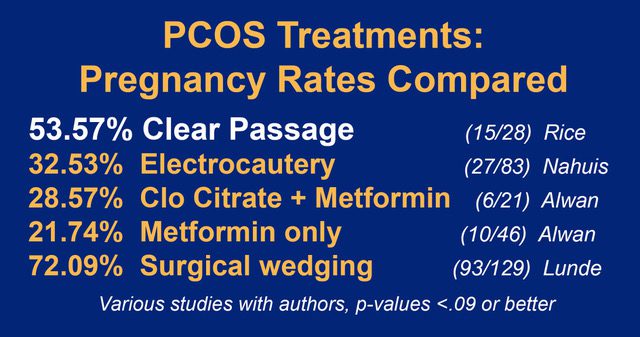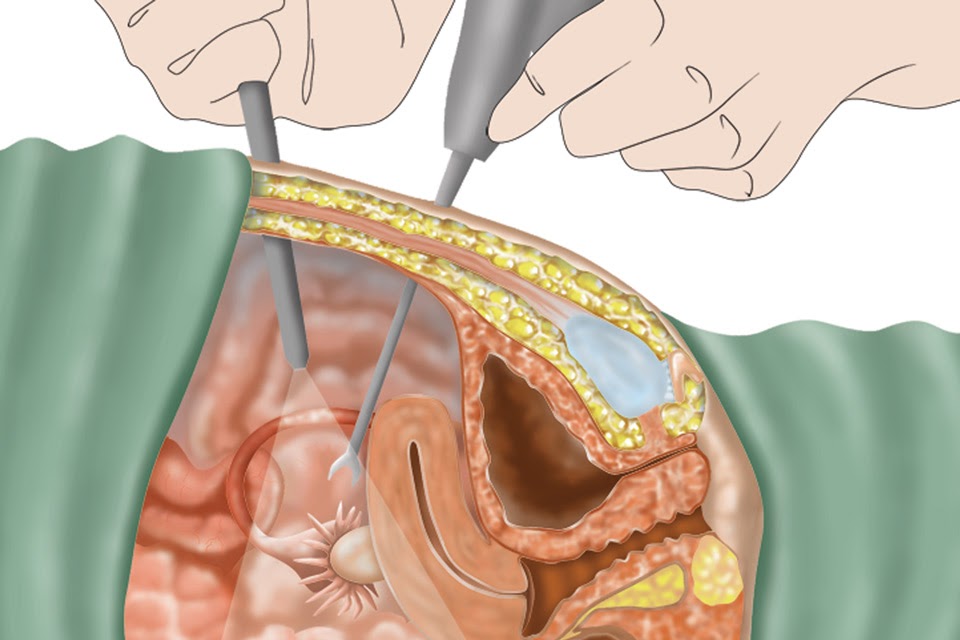Treating PCOS Infertility Naturally

Clear Passage®️ is a world leader with over three decades treating female infertility successfully without surgery or drugs. In a landmark 10-year study, our hands-on physical therapy yielded pregnancy rates for women infertile with PCOS at rates similar to standard medical treatments, but without surgery or pharmaceuticals (study chart below.)
During three decades of research and development, clinical trials showed numerous natural full-term pregnancies in women diagnosed with a variety of hormonal infertility conditions including PCOS, endometriosis and high FSH (advanced reproductive age). Numerous peer-reviewed medical journal citations show these results.
Perhaps the biggest advantage of using Clear Passage® for PCOS was to avoid the drugs and surgeries (e.g., drilling holes in the ovary, or cutting wedges from it) that are sometimes used to treat the condition. You can view these surgeries in the videos below:
- ovarian drilling (graphic), in which the surgeon drills holes in the ovary;
- ovarian wedging (graphic), in which the doctor removes a portion of the ovary.
Complete the online Request Consultation form to receive a free phone consultation with an expert therapist and learn more.
Clear Passage®️ Success Rates | |||
61% | 43% | 54% | 56% |
Opening Blocked Fallopian Tubes | Endometriosis Pregnancy Rate | PCOS Pregnancy Rate | IVF Pregnancies After CP Therapy |
Causes and Frequency of PCOS Infertility
PCOS is a major cause of female infertility, affecting between 8% and 20% of women worldwide.[i] Most women learn they have PCOS in their 20s or 30s when they consult their doctor about problems getting pregnant. PCOS can happen at any age after puberty.[iii] Women of all races and ethnicities are at risk of PCOS, but the frequency is higher in women who have obesity or have a mother, sister, or aunt with PCOS. As well as problems with fertility, women with PCOS can experience irregular menstrual cycles, changes in physical appearance (acne, weight gain, excessive hair growth), heart problems and increased risk for diabetes.
Signs and Symptoms of Polycystic Ovarian Syndrome (PCOS)
Signs are observations by physicians; symptoms are physical features noticed by the patient. PCOS signs and symptoms can be complicated. It is called a syndrome because PCOS can manifest in a multitude of symptoms or complications. This can make it harder for individuals to be successfully diagnosed with PCOS. These are the most common signs and symptoms:
- Hair loss
- No periods
- Depression
- Thinning hair
- Irregular periods
- Acne and oily skin
- Weight gain, overweight or obesity
- Hirsutism (excessive hair growth, commonly on face, back or chest)
- Infertility (trouble becoming pregnant after 12 months with no contraception)
If you have multiple indications from this list, there is a good chance that you have undiagnosed PCOS. You should make an appointment with your general physician or you can click here for for more information.
Hormonal and Mechanical Aspects
While considered a hormonal disorder, we speculate a mechanical aspect to PCOS in some women when ovaries become covered with collagen fibers, the building blocks of adhesions. Our thoughts are based on a combination of a) viewing thickened ovarian walls in surgical films, and b) witnessing a high number of infertility reversals in patients with PCOS after we treated them. Because our therapy addresses both the mechanical and the hormonal aspects of female infertility, we feel both aspects may be useful when treating patients with PCOS-related infertility. View success rates at our Calculating My Odds page.
As the name “polycystic” suggests, many cysts typically develop in the ovaries of a woman with this condition. These cysts or follicles (fluid filled sacs) contain eggs. But in women with PCOS, the ovary does not produce enough hormones for egg maturation. Unable to escape the outer covering, the follicles or cysts remain and build up in the ovaries, preventing ovulation. In addition, the ovaries tend to produce excess levels of androgens (male hormones) in women with PCOS, which can also negatively impact ovulation and fertility.
Addressing Both Aspects of PCOS
Successful reproductive activity depends on medically recognized communication between the ovaries (in the pelvis) and the pituitary/hypothalamus (PH) glands (deep in the cranium). Protected in a cavity within the sphenoid bone in the center of the skull, the pituitary gland is considered the “master gland” of female reproduction and is intimately involved in hormone production and regulation.
While physicians recognize a communication loop between the pituitary/hypothalamus and ovaries, the exact mechanism of that communication remains a mystery. This interplay among glands, called the hypothalamic-pituitary-ovarian (HPO) axis, is largely responsible for whether or not a woman’s eggs can reach maturity during the process of reproduction. Due to the positive results we have documented and published about returning fertility to patients with PCOS and other hormone-related infertility, we believe there is a strong mechanical mechanism in the body’s HPO communication loop that can be improved with our manual therapy.
Symptoms of Polycystic Ovarian Syndrome (PCOS)
PCOS can be a very complicated disorder. It is called a syndrome because PCOS can manifest in a multitude of symptoms or complications. This can make it harder for individuals to be successfully diagnosed with PCOS. These are the most common symptoms:
- Irregular periods
- No periods
- Infertility (trouble becoming pregnant after 12 months with no contraception)
- Hirsutism (excessive hair growth, commonly on face, back or chest)
- Weight gain, overweight or obesity
- Thinning hair
- Hair loss
- Depression
- Acne and oily skin
If you have multiple symptoms from this list, there is a good chance that you have undiagnosed PCOS. You should make an appointment with your general physician or you can click here form for more information.
Treatment Options
Clear Passage®️ Treatment
As physio/physical therapists, we regularly evaluate and treat the functions and mobility of the body’s physical structures, such as muscles, joints, organs and nerves. It is unusual for us to look at hormonal processes, which are regulated by the endocrine glands. Initially, it never occurred to us that we could affect hormone levels.
We began to question that assumption when women we treated who arrived with hormonal infertility including PCOS, high FSH, and endometriosis became pregnant in relatively high numbers after our therapy. As we saw this phenomenon again and again, we realized we had to investigate. In doing so, we found that many of these women had easy, natural pregnancies and delivered healthy full-term babies. As shown in our landmark 10-year infertility study, pregnancy rates for women with PCOS-related infertility demonstrated a 54% pregnancy rate (15/28).
Our success with women with hormonal disorders is due in large part to our work which combines therapy in the pelvis, up the spinal cord and dura and into the cranium. This continuum of structures which connects the pelvic reproductive organs to the pituitary/hypothalamus in the cranium exactly defines the HPO axis that is so important to reproductive physicians.
A major component of this route is the dura, a fascial sweater that surrounds the spinal cord from the bottom of the tailbone at the coccyx to attachments at the top of the neck and the base of the skull. From there, the dura enters the skull through a large opening (foramen magnum), then spreads out to surround the brain and every structure within the cranium. This includes the sphenoid bone and the pituitary-hypothalamus complex embedded in a fossa (depression) within that bone. Strong sheaths of the dura totally surround and infuse with the pituitary gland.
During the course of therapy, we treat the full continuum of reproductive structures including the dura and all of its attachments, from the ovaries, tailbone and into the head. Surrounding the spinal cord, this sheath can directly influence the central nervous system, responsible for a myriad of complex bodily activities and commands. Any adhesive restriction within that system between the reproductive organs in the pelvis and the pituitary/hypothalamus in the cranium can cause problems with reproduction.
To date, the results of our research treating hormonal conditions in women has been overwhelmingly positive. While we initially discouraged and even refused to treat women with hormonal infertility, experience has taught us that we can help in many cases. After reviewing their medical histories, we now encourage some women with hormonal conditions including PCOS, endometriosis, amenorrhea (no menstrual cycle) and high FSH levels to attend treatment. At the same time, we continue our research in these exciting areas.
No medical techniques have 100% success rate. If we are unable to open your tubes, your chances for a successful IVF performed within 15 months after therapy increase by roughly 50%, per published studies. View our success rates.
Calculate your odds with Clear Passage®️ therapy.
Read more about how to avoid surgery for PCOS.
Other Treatment Options (Surgery, Drugs)
As mentioned earlier, PCOS may be treated with pharmaceuticals or surgery. Each has its own advantages and disadvantages. Success rates appear to vary widely, depending on the approach, the provider and the specifics of each patient’s condition. In essence, there are far too many choices for us to examine on this website. We suggest you consult your physician and consult us to get all the information you can in order to make an informed decision of how to move forward.
Published Success Rates
The Clear Passage®️ Approach (CPA) demonstrated significantly higher rates of pregnancy when compared with metformin alone; the CPA treatment presented no significant differences in rates of pregnancy when compared with clomiphene citrate or the surgical interventions of ovarian wedging or drilling. We found such a variety of success rates in other medicinal and surgical interventions that it was difficult to create a meaningful comparison of Clear Passage®️ to surgery and pharmaceuticals, other than the above. Taken from the 10-year study, this chart gives some of our findings.








